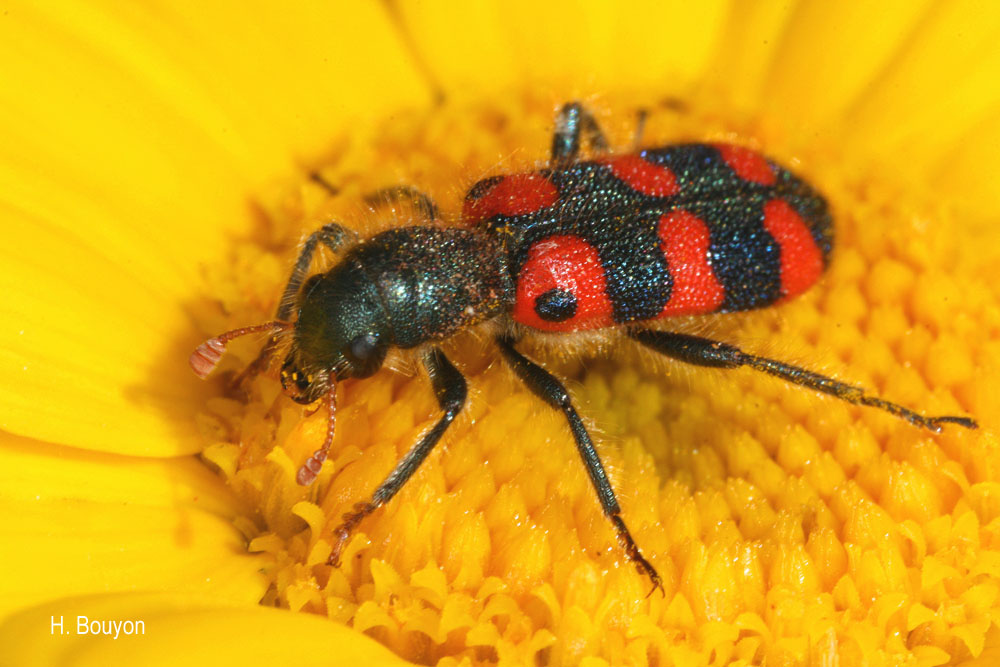
cd_nom

| Author : H. Bouyon |
 |
To get the picture, please visit:
Any reuse of one or more photographs on this site is subject to an authorization request from the author.
Link to the Code of Intellectual Property (Legifrance)

| Author : H.Bouyon |
 |
To get the picture, please visit:
Bouyon Hervé
herve.bouyon@wanadoo.fr
Any reuse of one or more photographs on this site is subject to an authorization request from the author.
Link to the Code of Intellectual Property (Legifrance)
Taille/poids :
7-13 mm
Diagnose :
Corps en cylindre large, densément couvert de pubescence, allongé, bleu acier métallique avec des taches rouge-orange sur les élytres. La pubescence est dorée, longue, hérissée. Les élytres sont densément ponctués, avec deux taches humérales laissant une macule bleue sur le calus huméral, deux taches médianes transversales et deux antéapicales transverses. Les fémurs postérieurs sont nettement renflés. Les antennes sont fauves, fines et courtes avec une forte massue de trois articles. Le pronotum est subcarré, nettement rétréci à la base, fortement et densément ponctué.
Détermination :
Difficile.
Espèces proches :
Les autres espèces du genre Trichodes de coloration similaire ont le calus huméral clair.
Période d'observation :
Mai à août.
Biologie-ethologie :
Espèce prédatrice dont les larves se nourrissent aux dépens des nids d'hyménoptères. Les adultes chassent sur les fleurs.
Biogéographie et écologie :
Cette espèce se trouve dans les milieux ouverts du Bassin méditerranéen.
Références :
Gerstmeier R., 1998. Checkered beetles. Illustrated key to the Cleridae of the Western Palaearctic. Weikersheim, Margraf: 241p.
H. Bouyon(ACOREP-France),2019
Continental
Metropolitan France
Overseas
Marine
Metropolitan France
Overseas
The map presents a summary at the 10 x 10 km grid of the observation data for the species transmitted to the SINP. These data have been subjected to validation filters.
The map presents a reference distribution layer of the species at the scale of departments and marine sectors. The presence and absence data were established by expertise within a network of partners. This reference distribution is used in the validation process of the SINP data at the INPN level.
Corresponds to a report on the basis of at least one observation proved within a period of 10 years (20 years for little-known invertebrates) preceding the year and no presumption of extinction since obtaining the last data nor doubt on reproductive and implemented nature of this population. For migratory species, the presence indicated concerns areas of reproduction.
This status is based on one or more of the following criteria:
This point covers the absence, more difficult by nature to demonstrate than presence. This status is based on one or more of the following criteria:
This status must be assigned to a department in which the presence of the species is casual.
Particular case of absence due to a proven extinction less than a half century ago (older disappearances are treated as "no probable or definite").
In the state of knowledge, we can not comment on the presence or absence in the current department. This is the default status when not comprised in one of the previous categories or whenever there is doubt.
The map shows the global distribution of the species based on GBIF data (Global Biodiversity Information Facility).
